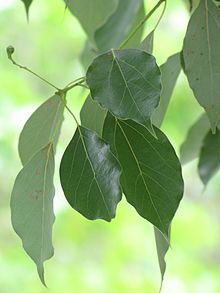- Cinnamomum parthenoxylon
-
Cinnamomum parthenoxylon Cinnamomum parthenoxylon Conservation status Scientific classification Kingdom: Plantae (unranked): Angiosperms (unranked): Magnoliids Order: Laurales Family: Lauraceae Genus: Cinnamomum Species: C. parthenoxylon Binomial name Cinnamomum parthenoxylon
Meisn.Cinnamomum parthenoxylon known in English as Selasian wood[1], Saffrol Laurel[2], or as Martaban camphor wood[3]. It has the outdated heterotypic synonym Laurus porrecta (Roxb.). The species name parthenoxylon derives from parthenos xylon (Greek: παρθενός ξύλον), meaning "virgin wood." The common name is Spanish is alcanforero amarillo[4] (in English: "yellow camphor") and it is thought to be the tree known in Khmer as mreah prew phnom (Khmer: ម្រះព្រៅភ្នំ). It is an evergreen tree in the genus Cinnamomum. It is native to Cambodia, Indonesia, Malaysia, Philippines, and Vietnam. In Vietnam, the tree is considered Critically Endangered[5].
Contents
Growth
The tree has gray to brown bark. Its leaves are a glossy green ovals 7–10 cm long with a point at the end. Like many plants in the Laurel Family, the leaves give off a pleasant smell when crushed. The flowers appear in clusters and are green and very small. The fruits are blackish drupes.[6]
In Indonesia the flowers of Cinnamomum parthenoxylon symbolize love and connection between the living and the dead. Traditionally, in the Kudus Regency on the island of Java, the flowers we scattered on tombs by family members.[7]
Uses
The tree is of special concern, as it is being harvested at a high rate to obtain safrole, a primary ingredient in the manufacture of the psychoactive drug MDMA. Much of this illicit harvesting is happening in the Cardamom Mountains in Cambodia[8]. The illegal harvesting is the subject of an episode of Vanguard[9]
An extract from the bark has been shown in rats to display hyperglycemic effects.[10]
References
- ^ Schimmel (April 1911). Annual report on essential oils, synthetic perfumes, etc: 43
- ^ Coster, B (1993). "Diskettes with commercial Woodnames". Tervuren Xylarium Wood Database. Hoofddorp, Holland. http://www.metafro.be/f48/xylarium/species/SN2793. Retrieved 4 December 2009.
- ^ Kurz, Sulpice (1875). Preliminary report on the forest and other vegetation of Pegu. Calcutta: C.B. Lewis, Baptist Mission Press. pp. xcix. http://www.archive.org/stream/preliminaryrepor00kurzuoft#page/xcviii/mode/2up/search/parthenoxylon.
- ^ Porcher, Michel H. (30 April 2007). "Sorting Cinnamomum names". The University of Melbourne. http://www.plantnames.unimelb.edu.au/Sorting/Cinnamomum.html. Retrieved 3 December 2009.
- ^ Asian Regional Workshop (Conservation & Sustainable Management of Trees, Viet Nam) (1998). "Cinnamomum parthenoxylon". IUCN 2009. http://www.iucnredlist.org/apps/redlist/details/33198/0/full. Retrieved 2 September 2009.
- ^ Sánchez de Lorenzo-Cáceres, José Manuel. "CINNAMOMUM PARTHENOXYLON". arbolesornamentales.com. http://www.arbolesornamentales.com/Cinnamomumparthenoxylon.htm. Retrieved 3 December 2009.
- ^ Hamdani, Sylviana (27 November 2009). "Five-Star Tradition at Le Meridien Hotel in Jakarta". The Jakarta Globe. http://thejakartaglobe.com/city/five-star-tradition-at-le-meridien-hotel-in-jakarta/344079. Retrieved 3 December 2009.
- ^ Campbell, Sam (30 August 2009). "Harvested to make Ecstasy, Cambodia's trees are felled one by one.". GlobalPost. http://www.globalpost.com/dispatch/asia/090812/drugs-ecstasy-cambodia?page=0,0. Retrieved 2 September 2009.
- ^ "Forest of Ecstasy". Adam Yamaguchi, Correspondent; Joanne Shen, Producer; Mike Horn, Editor; Yasu Tsuji, Editor. [[1]]. Current TV. 29 October 2009. No. 3, season 3. Retrieved on 8 July 2011.
- ^ Jia, Q; Liu X, Wu X, Wang R, Hu X, Li Y, Huang C. (August 2009). "Hypoglycemic activity of a polyphenolic oligomer-rich extract of Cinnamomum parthenoxylon bark in normal and streptozotocin-induced diabetic rats". Phytomedicine (Elsevier GmbH) 16 (8): 744–750. doi:10.1016/j.phymed.2008.12.012. PMID 19464860. http://www.phytomedicinejournal.com/article/S0944-7113%2808%2900244-4/abstract. Retrieved 2 September 2009.
External links
- Page on illegal harvesting in Khmer
- (Cinnamomum parthenoxylon) at Wikimedia Commons
- (Cinnamomum parthenoxylon) at Wikispecies
- (Cinnamomum parthenoxylon) at Integrated Taxonomic Information System
- (Cinnamomum parthenoxylon) at Encyclopedia of Life
- (Cinnamomum parthenoxylon) at IUCN Red List
- (Cinnamomum parthenoxylon) at Global Biodiversity Information Facility
Categories:- IUCN Red List data deficient species
- Cinnamomum
- Medicinal plants
- Data deficient plants
- Trees
- Trees of the Philippines
- Laurales stubs
Wikimedia Foundation. 2010.



